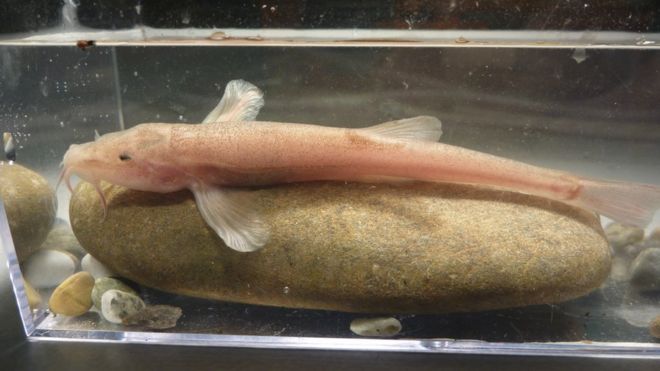Aquatic scientific names in the news …
5 th April 2017
The discovery of the first cave-fishes to be found in Europe has been announced in a paper published in Current Biology.

Image: Jasminca Behrmann-Godel
The fish, known for the time being simply as “barbatula” or “cave loach”, was discovered in 2015 by Joachim Kreiselmaier, an amateur cave diver who was exploring a hard-to-reach water-filled cave system named the Danube-Aach System which empties into the Rhine in Germany.
Genetic analysis suggests the cave-fishes are closely related to Barbatula barbatula, the Stone loach, which is found in the nearby Danube and the Radolfzeller Aach, a north tributary of the Rhine. It’s unsure at the moment whether they can be classed as a distinct species, comparison of their appearance and genetics with surface fish caught upstream and downstream from the cave suggests them to be a distinct lineage, with their own adaptations.
Although there has been no reason not to expect to find cave-fish in Europe, up until now they have not been seen; there are some 200 species of cave-fish living in various parts of the world with most of the known species coming from North America and China.
Discovering cave-fish in Germany was surprising as cave systems further south in the Balkans feature around 400 different cave-dwelling species, making it more likely that if cave-fish were to be found it would be there.
According to Kreiselmaier, who has so far brought back five live specimens, the section inhabited by the fish is very difficult to reach, accessible only in dry spells when the underground river is sufficiently calm and clear to allow exploration.
The genetic studies along with geological knowledge of the region suggest the cave loach population is comparatively young, diverging from river fish as the glaciers receded 16,000 to 20,000 years ago at the end of the last ice age. In evolutionary terms, this is very recent putting the new discovery at the younger end of the scale of cave-fish worldwide.
Despite the short time span, the fish demonstrate typical adaptions to subterranean life such as pale colouration, smaller eyes, along with larger barbels and nostrils.
Having lost the colouration of the surface population, a mixture of brown, green and yellow, they are pale, with a rose or pinkish tint, as the blood vessels are visible through the skin. The eyes are still there (some species of cave-fish lose the eyes completely) but are around half the size of those of the river fishes. They don’t appear to react to light but it is unclear whether they are still functioning. The larger, longer barbels may be an adaption to tactile sensing in the dark.
These loaches are also believed to be the most northerly species of cave-fish ever discovered.
Barbatula barbatula Linnaeus, 1758 – Stone loach
Etymology.
Barbatula – Latin, diminutive form of barbatus, with a small beard; having a small or foppish beard; name is a reference to the three pairs of mouth barbels.
Name is an example of a tautonym, where both genus and species name are the same.